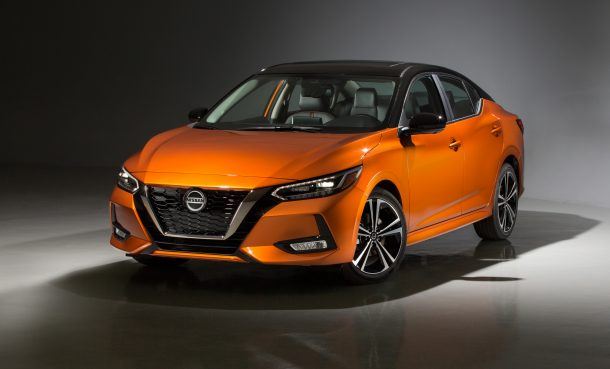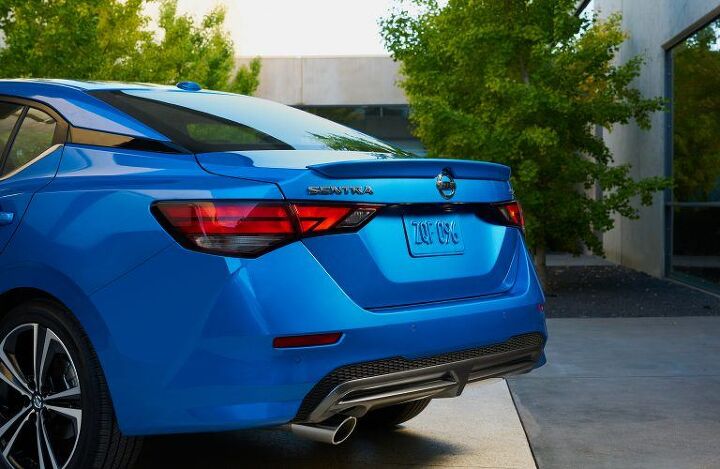Can You See Me Now? 2020 Nissan Sentra Debuts, Prepares to Fight Back Against Honda and Toyota

With America now fully retreated from the compact car space, Japan is left holding the bag in a dwindling market. For two automakers — Honda and Toyota — the abandonment of the compact car market has added wind to slackening sails, but their gain comes at the expense of other players. Nissan is one of those players.
With its next-generation Sentra, Nissan hopes to steal from its rivals’ plates and amass a bigger slice of the pie.
Let’s face it, the current-generation Sentra, while in possession of some serious value, suffers on the styling front — especially when placed alongside the popular Civic and new-for-2020 Corolla sedan. It’s boring to look at, and Nissan doesn’t want you to be bored.
Enter the 2020 Sentra. It’s wider than the last Sentra (by 2 inches) and also lower (by 2.2 inches). Yes, there’s a new platform underneath. It looks a lot like the Maxima, which Nissan bills as a sports sedan, and also like the Altima, which people actually buy. It even looks like the Versa, which underwent its own revamp for 2020. With a signature V-motion grille up front, angular bodysides, slim headlamps, and a floating roof (made all the more apparent in two-tone guise), this Sentra isn’t your buddy’s fiance’s Sentra.
You can order one of three roof combos, by the way.
Nissan claims the upgraded model revealed Tuesday night at the L.A. Auto Show raises the bar in terms in interior refinement and driving dynamics, rather than limboing under it. It’s refined and luxurious, Nissan claims, which are two words seldom applied to a Sentra.
“Extra attention was paid to the smallest of details to improve the perceived and actual quality of the new Sentra,” the automaker said in a statement. “The feel of the steering wheel in the driver’s hands, the smooth operation of the dials and switches were carefully crafted to create a premium feel.”
Premium is another word seldom applied to the Sentra. Of course, there’s a first time for everything, but it will take a spin behind the wheel to determine just how updated this compact sedan really is. By the sounds of it, comfort won’t be too much of a problem, with the company offering quilted, leather-appointed Zero Gravity front heated seats as an available nicety. Upgraded window, door, and body seals add up to a quieter cabin, the automaker promises.
Mercifully, the model arriving for 2020 also sees changes under the hood. Gone is the old Sentra’s 1.8-liter four-cylinder (good for 124 horsepower and 125 lb-ft when paired with a continuously variable automatic, 130 hp/128 lb-ft for six-speed models), replaced by a 2.0-liter unit making a healthier 149 hp and 145 lb-ft. Expect better fuel economy on top of the extra power, Nissan claims.
Unfortunately, the only transmission on offer is a CVT. It’s the latest Xtronic CVT, but still — it’s another death in the manual transmission family. No word on returning turbo NISMO models, either. Given the automaker’s financial problems and ongoing streamlining efforts, it’s not surprising to see reduced build configurations. It seems we’ve retreated to core Sentra.
Indeed, that’s exactly what has happened. For 2020, Sentra buyers will choose from only three trims: S (with hub-capped 16-inch wheels), SV, and SR. Just two options packages exist to temp buyers any further.
Elsewhere, there’s a new steering rack for improved feel, a revamped rear suspension, and standard Nissan Safety Shield 360 driver-assist features to go with existing safety nannies. All told, the safety bundle includes automatic emergency braking with pedestrian detection, blind spot warning, rear cross-traffic alert, lane departure warning, rear automatic braking, high beam assist, forward collision warning, driver alertness monitor, and rear door alert.
Headlights aren’t LED in base and mid-range trim, but the running lights are. LED projector headlamps and LED foglights adorn the SR’s face, and springing for that model also delivers a range of go-fast trappings to the table. Among them, side sills, 18-inch wheels, black side mirrors, black chrome grille, spoiler, and chrome exhaust finisher. That’s “finisher” — singular.
While entry-level Sentras make do with a 7-inch touchscreen and 4.2-inch driver information display, moving up one rung on the food chain brings aboard an 8-inch touchscreen and 7-inch driver’s display, with standard NissanConnect featuring Apple CarPlay and Android Auto connectivity. Base drivers will still get standard Bluetooth hands-free talk and text, Siri Eyes Free, and Google Assistant Voice Recognition.
Adaptive cruise control and an around-view monitor also populate the options list.
Going on sale in January, the 2020 Sentra is quite possibly Nissan’s last chance to retain brand loyalists and create new buyers in the compact space. It’s put together an attractive package, only one that lacks the ridiculous amount of choice offered to Honda buyers. Understandable, given the automaker’s present state.
And maybe Sentra buyers really don’t care about anything but the core product; honestly, when was the last time you saw a Sentra NISMO? The model’s current sales aren’t all that far off the model’s 21st century peak in 2017. We’ll see whether less choice and better product, combined with the brand’s signature value pricing, has the intended effect.
[Images: Nissan, Tim Healey/TTAC]

More by Steph Willems
Latest Car Reviews
Read moreLatest Product Reviews
Read moreRecent Comments
- Jalop1991 In a manner similar to PHEV being the correct answer, I declare RPVs to be the correct answer here.We're doing it with certain aircraft; why not with cars on the ground, using hardware and tools like Telsa's "FSD" or GM's "SuperCruise" as the base?Take the local Uber driver out of the car, and put him in a professional centralized environment from where he drives me around. The system and the individual car can have awareness as well as gates, but he's responsible for the driving.Put the tech into my car, and let me buy it as needed. I need someone else to drive me home; hit the button and voila, I've hired a driver for the moment. I don't want to drive 11 hours to my vacation spot; hire the remote pilot for that. When I get there, I have my car and he's still at his normal location, piloting cars for other people.The system would allow for driver rest period, like what's required for truckers, so I might end up with multiple people driving me to the coast. I don't care. And they don't have to be physically with me, therefore they can be way cheaper.Charge taxi-type per-mile rates. For long drives, offer per-trip rates. Offer subscriptions, including miles/hours. Whatever.(And for grins, dress the remote pilots all as Johnnie.)Start this out with big rigs. Take the trucker away from the long haul driving, and let him be there for emergencies and the short haul parts of the trip.And in a manner similar to PHEVs being discredited, I fully expect to be razzed for this brilliant idea (not unlike how Alan Kay wasn't recognized until many many years later for his Dynabook vision).
- B-BodyBuick84 Not afraid of AV's as I highly doubt they will ever be %100 viable for our roads. Stop-and-go downtown city or rush hour highway traffic? I can see that, but otherwise there's simply too many variables. Bad weather conditions, faded road lines or markings, reflective surfaces with glare, etc. There's also the issue of cultural norms. About a decade ago there was actually an online test called 'The Morality Machine' one could do online where you were in control of an AV and choose what action to take when a crash was inevitable. I think something like 2.5 million people across the world participated? For example, do you hit and most likely kill the elderly couple strolling across the crosswalk or crash the vehicle into a cement barrier and almost certainly cause the death of the vehicle occupants? What if it's a parent and child? In N. America 98% of people choose to hit the elderly couple and save themselves while in Asia, the exact opposite happened where 98% choose to hit the parent and child. Why? Cultural differences. Asia puts a lot of emphasis on respecting their elderly while N. America has a culture of 'save/ protect the children'. Are these AV's going to respect that culture? Is a VW Jetta or Buick Envision AV going to have different programming depending on whether it's sold in Canada or Taiwan? how's that going to effect legislation and legal battles when a crash inevitibly does happen? These are the true barriers to mass AV adoption, and in the 10 years since that test came out, there has been zero answers or progress on this matter. So no, I'm not afraid of AV's simply because with the exception of a few specific situations, most avenues are going to prove to be a dead-end for automakers.
- Mike Bradley Autonomous cars were developed in Silicon Valley. For new products there, the standard business plan is to put a barely-functioning product on the market right away and wait for the early-adopter customers to find the flaws. That's exactly what's happened. Detroit's plan is pretty much the opposite, but Detroit isn't developing this product. That's why dealers, for instance, haven't been trained in the cars.
- Dartman https://apnews.com/article/artificial-intelligence-fighter-jets-air-force-6a1100c96a73ca9b7f41cbd6a2753fdaAutonomous/Ai is here now. The question is implementation and acceptance.
- FreedMike If Dodge were smart - and I don't think they are - they'd spend their money refreshing and reworking the Durango (which I think is entering model year 3,221), versus going down the same "stuff 'em full of motor and give 'em cool new paint options" path. That's the approach they used with the Charger and Challenger, and both those models are dead. The Durango is still a strong product in a strong market; why not keep it fresher?








































Comments
Join the conversation
@Vulpine--Those are my concerns with the CVT as well. I don't even care that there is as much acceleration or that it feels different but I do care about wear of the belts and chains and that the fact that the ones Nissan offers cannot be rebuilt but have to be replaced at a cost of 4k to 7k. I don't even care as much if the vehicle has less than 150 hp and I don't expect it to last as long as many of the transmissions. Maybe 100k miles is the most Nissan can get out of the CVTs but then their vehicles should be priced a lot less. If the future is just CVTs and small turbo engines for ICE then I will be ready to switch to EVs. I don't want to pay a lot of money for something that is junk.
That would be acceptable at about $1,200 for a re-manufactured transmission.